

Paul Maric
2026 Toyota HiLux review: Prototype drive
1 Month Ago
It’s the flagship HiLux on price and positioning, but does the Rugged X’s tough truck pitch translate as an ultimate ute experience?



Journalist
New from
$23,590
excl. on-roads

Journalist
New from
$23,590
excl. on-roads


Journalist
New from
$23,590
excl. on-roads

Journalist
New from
$23,590
excl. on-roads
Quickly see how this car stacks up against its competition. Select any benchmark to see more details.
Where expert car reviews meet expert car buying – CarExpert gives you trusted advice, personalised service and real savings on your next new car.
Here it is, the tree-topping Toyota HiLux. Wanting for a tenner under 70 large before on-roads, promising hard-core off-roadability, fit for exploration on or off the beaten track.
It spruiks an Aussie-developed, pre-modded fit-out with the sorts of augmentation that might test road-worthiness and warranty should you pursue the traditional aftermarket route.
In Toyota’s eyes, it’s heaven on a jack-up stick for the discerning ute lovers.
How could the 2021 Toyota HiLux Rugged X be anything but a raging success? After all, it’s built off the HiLux SR5, a popular tier of Australia’s biggest-selling model line. There’s already well enough proof in that pudding that the donor vehicle has everything a good many buyers want or need.

Question is: is the stuff Rugged X brings to the SR5 package worth the added $10,000 investment? And that hinges a lot on who, or perhaps who else, the Rugged X attracts and how they might choose to use it.
Of course, a good many utes are primarily urban lifestyle runabouts and surrogate family haulers. And just because Toyota offers other HiLux variants – SR5+, Rouge – perhaps better suited for this sort of all-rounder role, the Rugged X conspicuously offers a rough-road-ready format with hassle-free convenience whether you’ll actually use its ultimate off-road capabilities or not.
People buy the Ford Ranger Raptor as a collectors’ item. An investment, perhaps. So why not a HiLux Rugged X, too? Have you seen used HiLux prices lately…?
Whether Rugged X hits the mark in the right areas or not depends largely on the buyer, but a glance across the features list and enhancements clearly favour style and presence over improved off-road capability, even if many of its mud-kicking mods are functional.

As mentioned above, the flagship of the HiLux range clocks in at $69,990 before on-road costs. Phew!
One rung underneath, saving a thousand bucks, sits the Rogue ($68,990), a sort of ultimate lifestyle package that, like Rugged X, is also based off the SR5 which, at $59,290 list, is over ten grand more affordable. And because more choice is better, it seems, there’s also a slightly fancier SR5+ clocking in at $62,420.
As outlined in our HiLux Rugged X versus Ford Ranger FX4 Max spec comparison, the natural Blue Oval nemesis clocks in at $65,940 list before you add optional adaptive cruise and a sticker set ($67,490) to align its feature set more closely with the Rugged X. Meanwhile, the range-topping Ranger Raptor wants for a fairly steep $77,690 list.

Elsewhere, the Isuzu D-Max X-Terrain wants for $62,900, the Mazda BT-50 GT is $56,990, the Mitsubishi Triton GSR is $53,490, the Nissan Navara PRO-4X is $58,130 and Volkswagen offers a pair of Amaroks in the TDI580 Aventura at $72,490, and the new Walkinshaw-fettled W580 at $71,990, that want for similar money if peddle slightly different road-oriented concepts. All prices exclude on-road costs.
Other off-road savvy utes for similarly rich dough include the now-defunct Mercedes-Benz X350d Progressive, which retailed at $73,270 new, and the Jeep Gladiator Overland at $75,450.
A choice of eight premium paint finishes outside of standard Glacier White adds $600.

Buy your new car without the stress. It's fast, simple and completely free.

Great service from Travis and team, second time I have used this business would not hesitate to recommend them to anyone
Craig C.
Purchased a Ford Ranger in Sunshine Coast, QLD
CarExpert helped Craig save thousands on his Ford Ranger, now let us save you on your next new car.
Find a dealSo where does your extra $10k over the SR5 go?
You don’t have to squint hard to see that, at fifty paces, the Rugged X goes for maximum visual impact. Beauty in the beholder’s eye, of course, but there a lot going on outside in the pursuit of style even if, logically, so much of the added stuff is actually functional and to varying degrees benefits its ‘tough truck’ aims.
Changes impacting appearance include Tacoma-inspired fender flares, matching plastic tailgate garnish, a heady-duty steel rear bar, a wider grille, integrated bull bar, a bash plate, rock rails, reversible snorkel, rollover bar, a tub tray with tailgate protection, bright red recovery points and revised front driving lights and LED light strip which all yell “chuck me towards the mulga” even before you take into account the Oxide Bronze paintwork – it’s more a pearlescent green – and the look-at-me satin black graphics.


The Rugged X downsizes wheel size from SR5-spec 18 inches to 17s, and fits heavy-duty front springs. Otherwise, there’s little other difference to the SR5 under the skin. Tyres are 265/65 Dunlop Grandtrek All Terrains.
Inside, the Rugged X fits the same nine-speaker premium-grade JBL audio, eight-way power adjustment for the driver’s seat, leather-accented trim and front seat heating as found in the Rouge though, apart from all-weather mats, there’s not much else unique in the flagship’s cabin.
Features shared with SR5 include auto-levelling LED headlights, a tow bar with seven-pin harness, adaptive cruise control, push-button start, single-zone climate control with rear vents, a cooler box, reversing camera and privacy glass. It does lack rear parking sensors and mirror heating found on lower-spec HiLuxes, however.
Infotainment is an 8.0-inch touchscreen with sat-nav, DAB+ radio, Bluetooth, as well as Apple CarPlay and Android Auto smartphone mirroring. Also fitted are dual 12V/120W outlets in the central stack and a 220V/100W three-pin outlet in the console bin to compliment the single USB port up front.
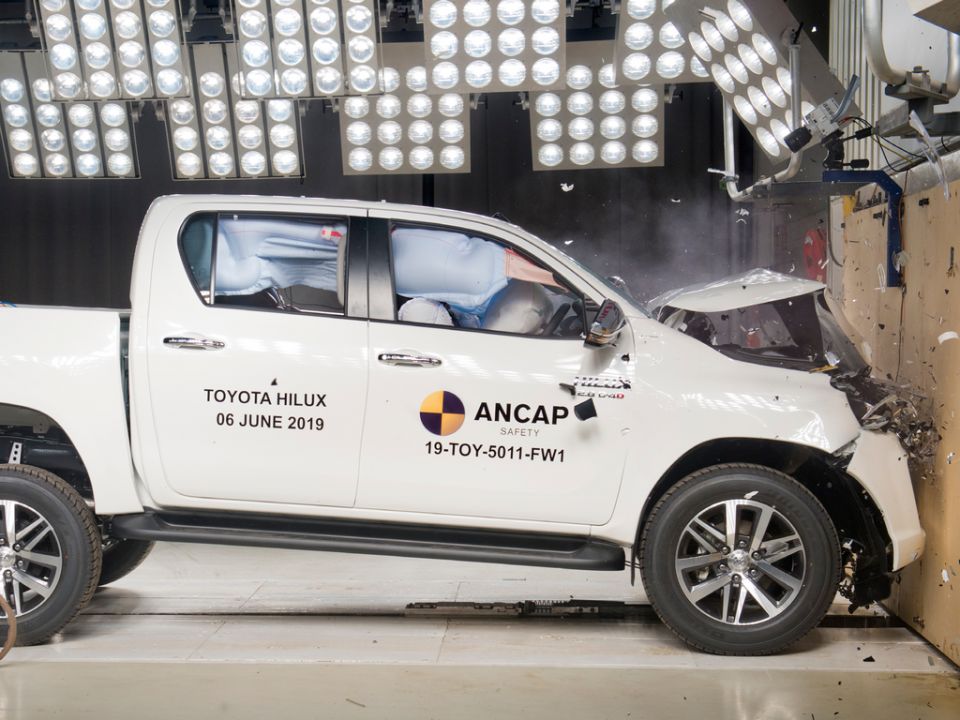
According to ANCAP, “all variants” of the current range carry over this current eighth generation’s five-star rating that came into effect in mid-2019 with the inclusion of autonomous emergency braking across the entire range. The AEB design is all-speed (up to 180km/h) with pedestrian and daytime cyclist detection up to 80km/h.
However, the ANCAP technical report name-checks variants throughout the range, including Rogue, though does not make specific mention of Rugged X. Of course, it’s possible that our review subject’s unique integrated bull bar might differ in vulnerable road user safety attributes compared with other HiLuxes. Still, with “all variants” covered…
As it stands, HiLux scores 96 and 87 per cent for adult and child occupant protection respectively, with 88 per cent for vulnerable road user and the 78 per cent for safety assist.

Those assistance systems include lane departure warning and a sort of lane-keep assist, though it’s not lane keeping via steering, per se, as it features hydraulic rather than electric steering. Instead, the lane-keeping functionality is actuated via braking. Road sign assist is also fitted.
The SR5 fits seven airbags covering front, side, curtain and driver’s knee. The automatic limited-slip differential feature is essentially electronic engine and braking control that aids when off-roading and wheel loses traction. It also fits two top-tether and two ISOFIX mounting points in row two.
As mentioned above, the Rugged X fits a reversing camera but has no parking sensors front or rear.
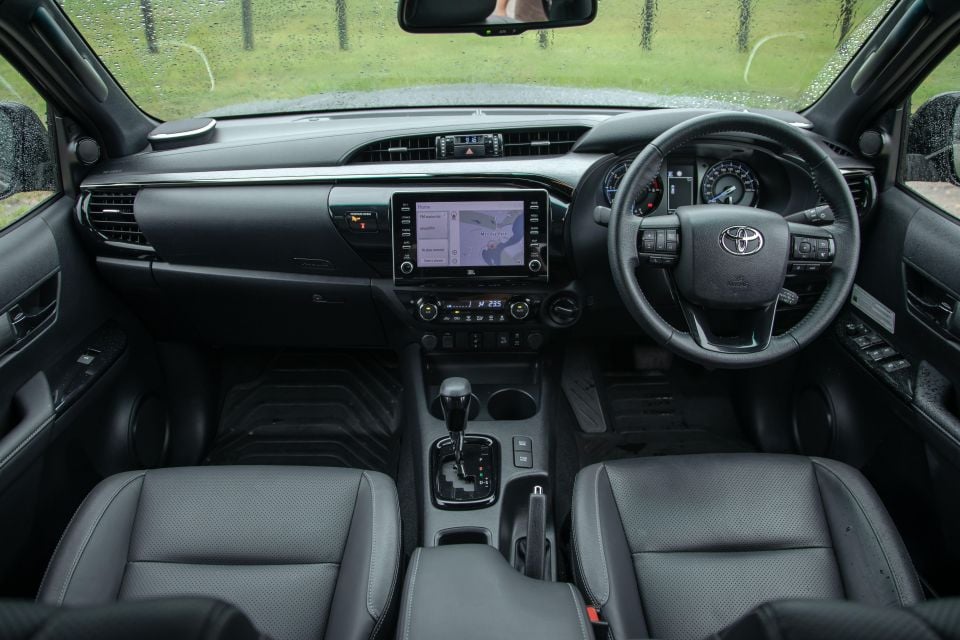
Two things initially strike about the cabin. Firstly, it’s incredibly plasticky. And, secondly, not much of it is distinctly and individually ‘Rugged X’.
It’s not such a big foul on the first point: downmarket cabin execution is typical even in the higher reaches of the dual-cab ute set and it certainly hasn’t hamstrung the popularity of the segment and the big-selling HiLux.
Black shiny plastic surfaces, gloss black plastic highlights, satin-brushed alloy-look plastic trim inserts, the ‘partial leather’ wheel that feels suspiciously like vinyl – it all appears perfectly serviceable for hosing out if you’re one of those muddy mountain biking/dirt biking/camping types that appear in ute television adverts. Not recommended practice, though.
It’s the sort of interior vibe you’d possibly expect from a ute called Rugged X. But if you’re after a nice upmarket vibe for running around town and ferrying the kids to school, this HiLux isn’t the one for you.




Even the leather-appointed seat trim demands close examination to determine exactly what is leather (perforated seat face centres) and what’s clearly vinyl (bolsters and much of the rest of the trim).
There’s no Rugged X stitching or signage, no distinct colours or graphics to remind you that, no, this isn’t your average SR5 (where these seats are optional).
Familiar, then, are things such as the slightly fancy ‘machinery themed’ instruments flanking the 4.2-inch colour driver’s screen that now, thankfully, offers a digital speedo.
Ditto the modest 8.0-inch touchscreen with its modest brightness and sharpness, its rudimentary sat-nav design and a reversing camera viewpoint that large if grainy and only offers static guidelines. The JBL premium audio, which plonks the mid-range speaker ahead of the tweeters atop the dash, has a sound quality that’s decent if hardly rave-worthy.


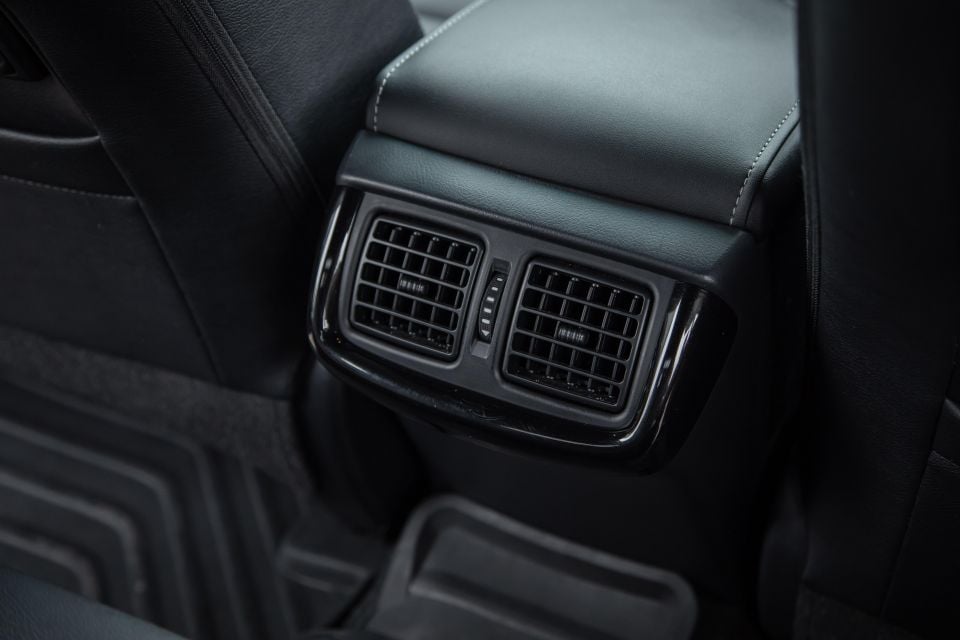

It’s all workmanlike, functional and serviceable stuff and nice in an honest sort of way. But very little of the Rugged X cabin feels distinct, special or worthy of the sort of money this flagship ute wants for.
There is some neat stuff – the chilled cubby above the glovebox is handy while the dual 12V outlets and the 230V three-pin outlet in the console will power devices most vehicles can’t. But the solo USB outlet, lack of inductive phone charging, and the cupholders that lack spring-loading capture leaving your bottles to rattle around smacks of doing things a little on the cheap side.
The front seats offer middling support and are reasonably comfortable in contour, though they lack driver’s side lumbar adjustment and the leather that does feature in areas isn’t all that tactile. The seat heating controls appear a fiddly afterthought and, in terms of control placement, there’s not quite enough steering wheel reach adjustment.
Row two is a little claustrophobic, with little legroom and limited headroom, if mostly because the rear seat base is set so high. This isn’t necessarily a bad thing for kids, because it affords excellent visibility to the front row and out of the windows.
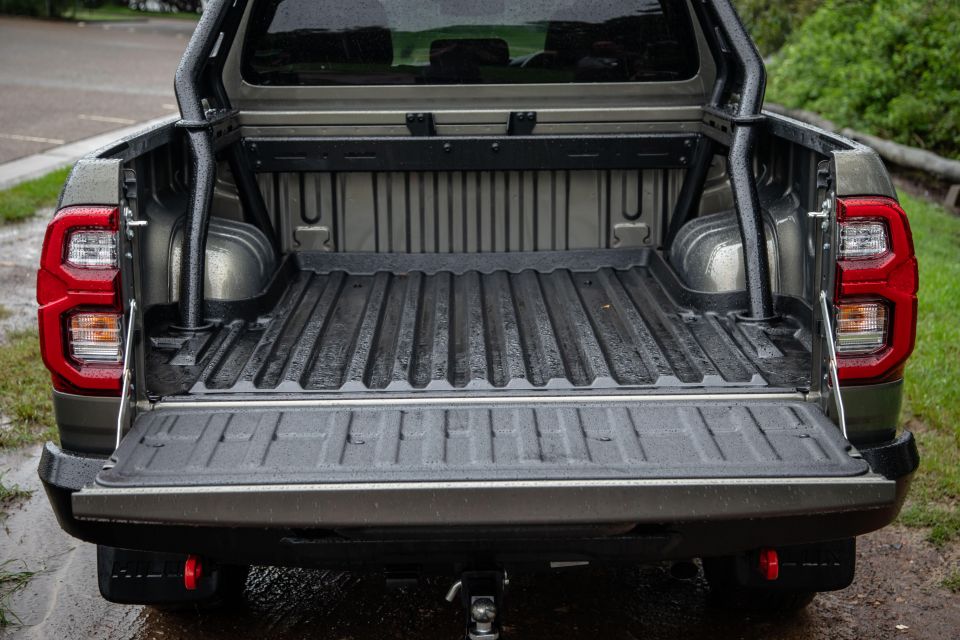



But it’s not so great for adults, particularly the overhead grab handles that hover close to your head. A plus is that the HiLux fits grab handles on the A- and B-pillars on both sides of the cabin, and the rear air vents are a welcome inclusion though there’s no device connectivity to speak of in the second row.
There’s no lockable electric tonneau or carpeted tub as you find in the Rogue, but rather a basic and hardy plastic liner across the tub floor, walls and tailgate skin.
Not the most secure load area for your valuables, then. It’s a hefty tailgate, too, with metal hinges rather than dampening hardware.
The steel sports bar does eat into a little bit of cargo space but it does have a tie-down rating of 200kg.

The stalwart 2.8-litre turbo-diesel four was significantly updated for MY20 to offer 150kW and 500Nm – 20kW and 50Nm up on its forebears – to more closely match key rival Ranger’s 2.0-litre Bi-Turbo diesel, which now only has a seven-kilowatt advantage.
Changes included a new engine block, gaskets, exhaust manifold, a larger ball-bearing turbocharger and a higher-pressure common-rail injection system, yielding more favourable fuel economy and a broader torque spread in the mid-range.
Toyota also licked some issues with the 2.8L unit’s diesel particulate filter system, which we went into detail during our review of the Rogue.

Where expert car reviews meet expert car buying – CarExpert gives you trusted advice, personalised service and real savings on your next new car.
It’s backed by an evergreen driveline comprised of a six-speed auto teamed with selectable four-wheel drive with familiar 2H-4H-4L switching and a rear differential lock as standard.
Fuel economy? At 8.4L/100km, the Rugged X’s claim is identical to that of the old SR5 dual-cab pick-up auto – which are both half-a-litre thirstier than the updated SR5 dual-cab auto.
Why does the Rugged X lose out in economy? Well, at a hefty 2316kg it’s just over a quarter-tonne heavier than the SR5 ute (2055kg) it’s based off. Clearly much of the Rugged X kit you’re forking out an extra $10k for weigh in on the scales, too.
On test, using mixed urban and highway driving, our review machine tended to hover between sevens on the highway and double figures around the ’burbs.

The elephant in the bushy room is that, unlike the suspension and tyre mods featured in arch-rivals like the Ranger FX4 Max or Raptor, little has been gifted to Rugged X’s underpinnings to boost serious off-roadability. A larger aspect-ratio (70 series) mud-chucking tyre, like the Fords’ BF Goodrich rubber, would do wonders to boost the Toyota’s appearance alone.
Again, we detailed the Fords’ suspension and steering mods, and the related ground clearance effects, in our spec comparison, but the Toyota’s absence of chassis enhancement to separate the Rugged X from its SR5 base is a bit of a disappointment regardless of how capable the SR5 is across the rough stuff.
Critical specs? Ground clearance is a modest 236mm while payload is, at 734kg, hardly top of the class. Towing, though, is on the money for the dual-cab segment, with a maximum 3500kg braked rating and 750kg when unbraked.

The longer rear leaf springs, wider spring spacing, retuning of spring, damper and bushing rates all round as well as revising the cabin mounts were all introduced in the last HiLux update for the diesel 4×4 versions. As a springboard, then, the Rugged X leaps from a nicer and more settled place than owners of older HiLuxes are accustomed to.
This newer 2.8-litre diesel is a little more confident and less strained on the march these days, though a bit of clatter under load is still apparent. Still, torque is fulsome in the mid-range and response is clean and instantaneous off the mark from low down.
Where this powertrain does become limited against its rivals is its relatively narrow-band sweet spot between peak torque clocking on at 1600rpm and the engine becoming a bit gruff and strained much beyond 3000rpm, a bit short of its 3400rpm power peak. It works a treat in that window, though with only six forward ratios to work with it feels slightly inflexible, even if the auto is well calibrated and plucks the diesel’s goodness well.
The byproduct is that, at times, it almost feels like you’re driving a CVT, such is the HiLux’s keenness to keep the tacho needles hovering around the 2000-2500rpm band under acceleration.
It doesn’t feel that swift as it could be – or, to be more accurate, it’s not as swift on its rubber as the quarter-tonne-lighter SR5 on which it’s based. But, again, when it does get moving there’s no sense of excessive sweat or strain, and the lift in throttle response Power mode brings will tempt you to keep that mode activated permanently.

The jury is out with towing. The old powertrain did start to feel the strain once you attached a decent load to the tow kit, and we expect the new unit’s extra pep should serve it better lugging around a decent-sized trailer or caravan.
The ride quality is better and noticeably so for no other reason than the pre-MY20 HiLuxes were so memorably terrible. Despite the heavy-duty front springs, the front end remains a bit more compliant across bumps than the rear end or, to be more accurate, an unladen rear end, which becomes sharp and unsettled across speed bumps.
It’s no Ranger, let alone Ranger Raptor, when it comes to ride quality, but this is certainly a sign the HiLux heading in a nicer, more liveable direction. Its more settled nature means it suppresses vibration more confidently and the general upshot is a more dignified and refined on-road experience.
Yes, Toyota did fiddle with the hydraulic steering hardware in the last update, but the direction finder remains leaden and cumbersome to use. It’s fine on the move, but at a crawl or when attempting to park its formidable 5.35-metre form – the longest of all current HiLux variants – it starts to get tiresome.
I suspect that while HiLux resists the move to electric steering assistance enjoyed by rivals it’ll remain an also-ran for driving friendliness.

It is, at times, a tough thing to manoeuvre and park – that steering, a fairly lazy turning circle, the lack of parking sensors and an integrated front bull bar that disappears well beyond the bonnet line. Add its sheer length, and it means you have to shoehorn it into many parking spaces, particularly in town.
Off road, it’s unsurprising the Rugged X doesn’t really offer much extra in traction, articulation or clearance than the regular SR5 or the Rouge. Its stats are similar, too: the aforementioned 247mm of clearance, a 29-degree approach angle and 27-degree departure angle, plus a wading depth of 700mm.
But that’s no bad thing because the HiLux has long been one of the handier options in the ute segment when it come to tackling the rougher stuff.
Its 4H mode works well for the lion’s share of broken surfaces, and despite the closed tread of the Dunlop Grandtreks, grip is decent and there’s a decent amount of agility and keenness to respond to inputs despite the ute’s considerable hefty. However, whether or not it’s actually any dynamic improvement over a more lightweight SR5 is highly debatable.
Low-range does what’s claimed on the box and it’s here – and only here – where you can bring the rear diff lock into play, which much like the rest of the HiLux package delivers in its role well. The hill descent control, too, works an absolute treat.
So far so good, but if there’s an overarching theme with Rugged X’s off-road capabilities it’s that it really doesn’t bring many tangible advantages over other HiLux stablemates with similar, if not nigh on identical, mechanical and electronic make-up.

The HiLux comes with a five-year, unlimited-kilometre factory warranty.
Servicing intervals are a scant six months (if 10,000km) at $250 per service.
The $500 annual outlay works out to be more expensive than the Ford Ranger ($299 per 12-month/15,000km interval) with twice as many stints off the road per year.

Evidence suggests the Rugged X is best suited to the HiLux devotees and completists who are really after something exclusive and collectable.
And while a lot of the added addenda does offer extra protection in an off-road environment, the Rugged X isn’t necessarily more off-road capable than the SR5 and Rogue. Besides, you have to question how tough the intentions are in a pick-up painted in an expensive-to-repair pearlescent finish.
It’s fair to say the Rugged X charts a different course to rival Ford in the Ranger Raptor and FX4 Max, as it doesn’t offer the same sort of upgrades to underpinnings, traction and clearance. You have to point this or any other HiLux towards the aftermarket to uncork a similar sort of off-roading focus.
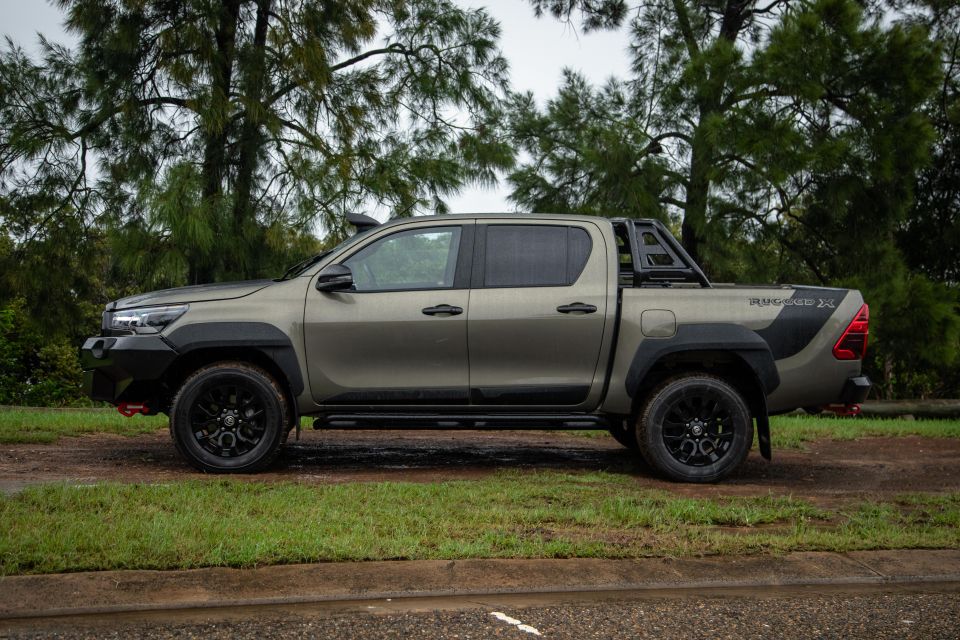
As an all-rounder, it maintains all of the HiLux traits so many buyers love and more, and while recent updates have addressed issues with outputs and general refinement, the breed is starting to feel its age and throwing $10k worth of feel-good extras on top can’t mask it. As a more urban centric dual-cab, you’re better off with the Rogue.
The HiLux could be better in cabin materials, tech, safety and even the features it fits to high-end variants such as Rugged X, regardless of how popular it is.
That’s because under the critical lens it’s starting to be left behind is some areas by a segment that continues to lift its game higher.

Click the images for the full gallery
Where expert car reviews meet expert car buying – CarExpert gives you trusted advice, personalised service and real savings on your next new car.


Paul Maric
1 Month Ago
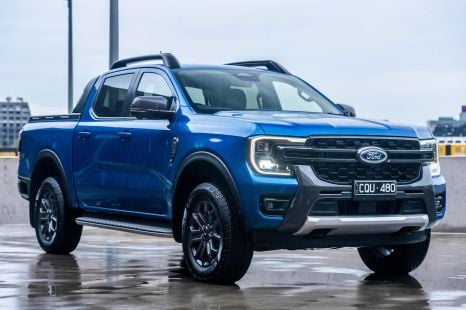

Max Davies
28 Days Ago


James Wong
18 Days Ago


Ben Zachariah
17 Days Ago


Matt Campbell
9 Days Ago


Ben Zachariah
3 Days Ago